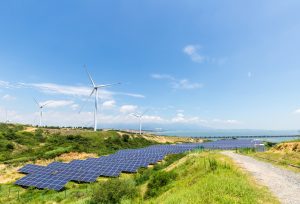On August 2, 2024, China’s National Development and Reform Commission (NDRC) and National Energy Administration (NEA) jointly released updated requirements for what percentage of energy provinces will need to source from renewable generators in 2024 and 2025. The requirements are a part of China’s renewable energy consumption guarantee mechanism and mandate a significant increase in the share of renewable energy in a number of provinces, as well as enumerating tentative renewable energy consumption targets for 2025.
China’s renewable energy consumption guarantee mechanism was introduced in 2021 as a way to increase domestic renewable energy consumption. The mechanism is very similar to a “Renewable Portfolio Standard,” a policy favored by Western governments including the United States and the EU.
The renewable energy consumption guarantee mechanism sets two targets: one for total renewable energy consumption and one for non-hydro renewable energy consumption. When it was introduced in 2021, the mechanism included a goal of ensuring that 40 percent of total national energy consumption by 2030 would come from renewable sources, including hydropower. This is crucial to China being able to peak emissions by the same year and reach carbon neutrality by 2060 – especially because even as renewable energy capacity continues to boom in China, consumption hasn’t always kept up.
In this context, these targets take on renewed importance because they are one of the most direct tools for mandating increases in renewable energy consumption.
The 2024 targets demonstrate that six provinces saw greater than 6 point increases in their renewable energy consumption mandate between 2023 and 2024. Heilongjiang saw the highest increase, with the required share of non-hydro renewables jumping from 22.7 percent of total energy consumption in 2023 to 30.0 percent in 2024. Hainan, Henan, Jilin, Hunan, and Gansu also saw increases greater than 6 percentage points.
Conversely, Sichuan, Guangdong, Fujian, Zhejiang, Yunnan, and Xinjiang saw the lowest increases in their targets. None of those six provinces are mandating increases greater than 1.5 points.
Based on this data, China is on track to meet its renewable energy consumption goals. For renewable energy including hydropower to account for 40 percent of total national energy consumption by 2030, the renewable and non-hydro renewable consumption share needs to grow at 1.3 points and 1.5 points per year. From that perspective, only three provinces (Zhejiang, Yunnan, and Xinjiang) fell short. The huge growth in the six provinces listed above more than makes up for those shortfalls, and means that the mechanism is serving its purpose.
The only potential cause for concern in the August 2 update came from the tentative mandates for 2025. In addition to articulating the binding targets for 2024, the policy update also announced tentative targets for 2025. This is done every year, and the targets are updated the subsequent year when they become mandatory. For the four provinces whose 2024 mandates were the highest – Jilin, Heilongjiang, Qinghai, and Ningxia are required to supply 30 percent of their power needs from non-hydro renewable sources – the tentative mandates for 2025 are unchanged.
Right now, it isn’t clear why. Those four provinces will definitely install more renewable energy capacity between now and 2025, and their renewable electricity consumption is almost guaranteed to increase in absolute terms. It might signal that the NDRC and NEA project increases in fossil fuel consumption in those four provinces over the next 18 months, which could mean that renewables will stay constant as a share of total energy consumption even if they grow in absolute terms.
More likely is that these are very conservative estimates that will be revised when they become binding, likely in August 2025. This was the case for the 2024 estimates. On August 4, 2023, when the 2023 edition of this update was released, the tentative mandate for Heilongjiang was that they would be required to source 24.4 percent of their energy from non-hydro renewable sources in 2024. The final number was significantly higher, and that pattern is consistent for all of the six provinces which saw increases greater than 6 percentage points.
Conservative estimates give policymakers more leeway to revise the mandates between now and when they actually become binding. Revising the targets up rather than down is likely to generate less angst, and for provinces whose grids already consume a significant share of renewable electricity, this gives policymakers more time and information so that the eventual targets more accurately reflect energy installations on the ground. From this perspective, increasing the 2025 targets is more a question of “when” and “by how much” rather than “if.”

































